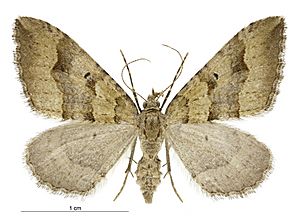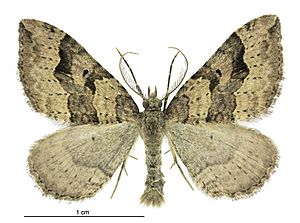New Zealand looper facts for kids
Quick facts for kids New Zealand looper |
|
|---|---|
 |
|
| Female | |
 |
|
| Male | |
| Scientific classification | |
| Kingdom: | |
| Phylum: | |
| Class: | |
| Order: | |
| Family: | |
| Genus: |
Epyaxa
|
| Species: |
E. rosearia
|
| Binomial name | |
| Epyaxa rosearia (Doubleday, 1843)
|
|
| Synonyms | |
|
|
The New Zealand looper, also known as the plantain moth, is a type of moth found only in New Zealand. Its scientific name is Epyaxa rosearia. This moth belongs to the family Geometridae, which are often called "looper moths" because of how their caterpillars move.
Contents
What Does the New Zealand Looper Look Like?
The New Zealand looper moth changes its appearance as it grows. It starts as a tiny egg, then becomes a caterpillar, and finally a moth.
Eggs and Caterpillars
The eggs of the New Zealand looper are pale yellow and have a smooth, oval shape. When they hatch, tiny caterpillars emerge. These caterpillars are light green. They have faint whitish lines running along their bodies. A narrow green stripe goes down their back, bordered by white lines.
The caterpillar's body tapers (gets narrower) towards its head, which is greenish-yellow. When the caterpillar contracts, you can see yellowish or whitish rings where its body segments join. These caterpillars are often found among leaves on the forest floor.
Chrysalis Stage
After growing, the caterpillar forms a chrysalis. This is a shiny, very dark brownish-black casing. Inside the chrysalis, the caterpillar transforms into an adult moth.
Adult Moths
Adult New Zealand looper moths can look quite different from each other. Some might have a pinkish color. Others can be brownish. Olive green is also a common color for these moths.
Where Do New Zealand Looper Moths Live?
The New Zealand looper moth is very common. You can find it all over New Zealand. It is considered endemic, which means it naturally lives only in New Zealand and nowhere else in the world.
What Do New Zealand Looper Caterpillars Eat?
Even though the New Zealand looper moth is native to New Zealand, its caterpillars have mostly been seen eating plants that are not originally from New Zealand. These are often called "exotic" plant species.
Some of the plants they have been recorded feeding on include:
- Watercress (Nasturtium officinale)
- Ribwort plantain (Plantago lanceolata)
- Kura clover (Trifolium ambiguum)
- White clover (Trifolium repens)
- Nasturtium (Tropaeolum majus)
- Caucasian clover (Trifolium caucasicum)

